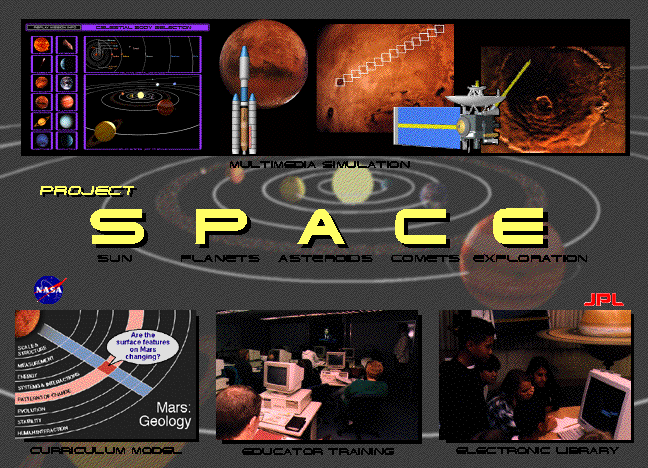
Approach: By providing computer-based interactive simulations (SPACE Simulation), multi-discipline integrated activity based curricula (SPACE Curriculum), and an electronic curriculum library (SPACE Library). Project SPACE will increase educator & student, science & technology, awareness & understanding. The computer-based multimedia simulation allows educators and students to plan and execute a robotic mission to Mars. NASA offices sponsoring this technology education project are the Office of Aeronautics, Space Science Division, and the Education Division. Other JPL projects /program offices provide technical support, visualization, imaging, mapping, data modeling, micro-devices, and design tools for Project SPACE. A coordinated approach allows Project SPACE to leverage resources, be economical, serve as a model to other NASA projects, and provide useful outreach products. All products developed will be shared with other NASA Centers for regional access. The in-service training with local educators (Teacher Education Program) will demonstrate the use and application of the Simulation, Curriculum, and the Electronic Library components of the project. The SPACE Electronic Curriculum Library uses the Internet as a vehicle to disseminate NASA/JPL data and information nationwide to educators and students.
Accomplishments: The SPACE Simulation (Mars Phase, Alpha Version) has been delivered; product test/evaluation has begun, with 13 specially selected Educational Partners, located throughout California. The ``Web'' graphical integration model is complete, the Mars ``Web'' curriculum support products are nearing completion. The ``Web'' model is being used to create curricula that support current instructional pedagogy, science frameworks and national standards. Use of this design promotes student interest, and aids in the incorporation of planetary science curriculum directly into classroom settings. The SPACE Electronic Curriculum Products Library has been on-line on the Internet since Jan. `93, and is used by more than 1,200 teachers /students each week. The first of many curriculum products, lesson plans and hands-on activities are now available.
Significance: Project SPACE helps to fill customer demand for NASA technology education products. It benefits educators & students by providing a platform for them to understand the relevancy of NASA project & program data. The Simulation uses interactive multimedia technology to translate complex datasets into meaningful learning experiences that increase knowledge and awareness of NASA's role. The Curriculum model can be integrated into any traditional science discipline. The model employs current science education reform pedagogy and theories. The Electronic Library employs low cost dissemination vehicles to aid large numbers of learners throughout our country.
Status/Plans: Project Elements: Current: Future: Simulation Mars, Alpha Version Mars Phase, & other bodies Curriculum Web Design Model Saturn ``Web'' & other bodies Library On-line on Internet Web Interface, Expand product line Teacher Education Design model underway Implement and field test Partnerships 13 School Partners Apple Computer Inc., CSUDH.
Point of Contact:
Michael A. Garcia
Jet Propulsion Laboratory
m.a.garcia@ccmail.jpl.nasa.gov
(818) 354-6397